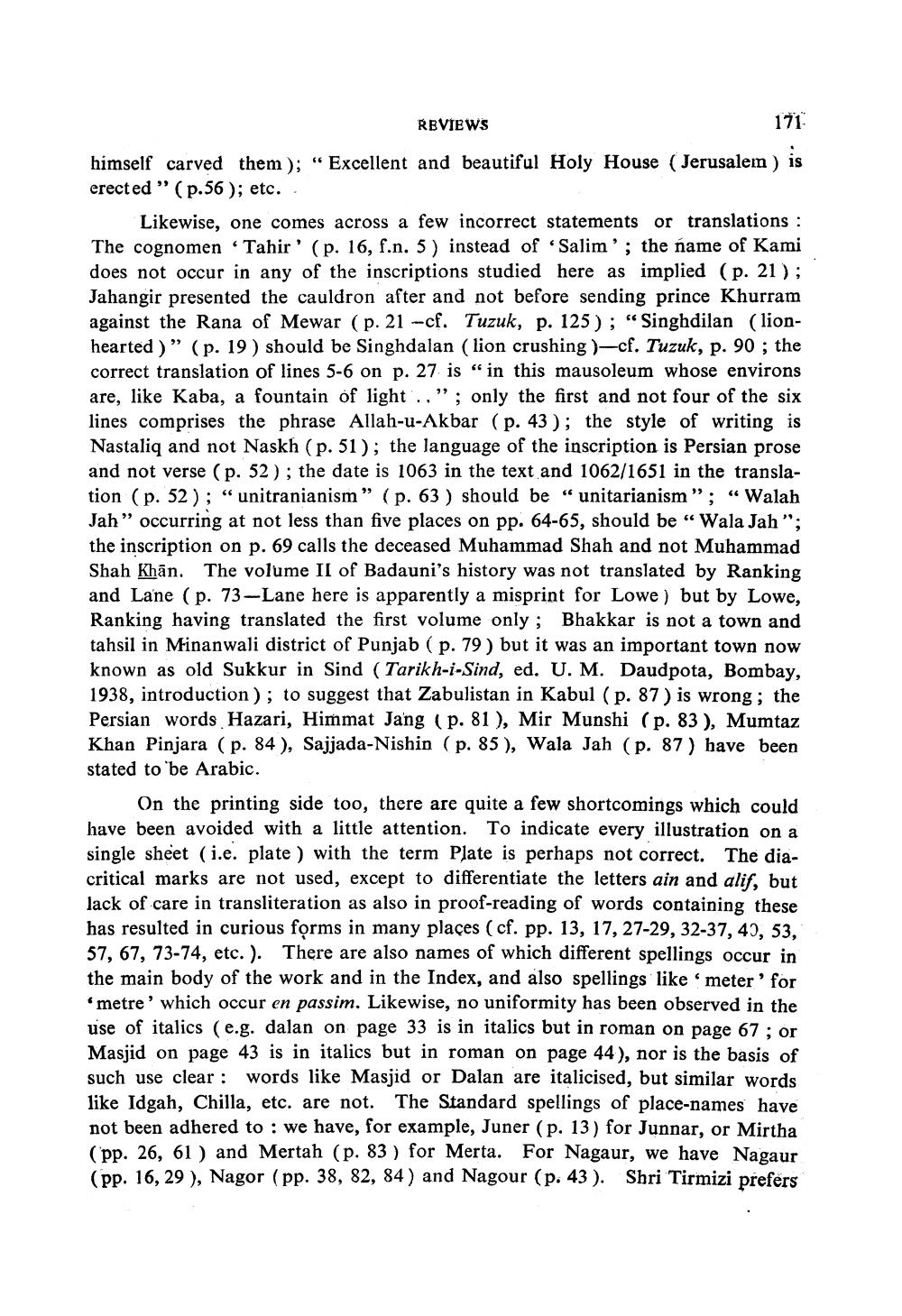Book Title: Reviews Of Studies In Indology Author(s): J S Jetly Publisher: J S Jetly View full book textPage 5
________________ 171 himself carved them); "Excellent and beautiful Holy House (Jerusalem) is erected" (p.56); etc. REVIEWS Likewise, one comes across a few incorrect statements or translations: The cognomen Tahir' (p. 16, f.n. 5) instead of Salim'; the name of Kami does not occur in any of the inscriptions studied here as implied (p. 21); Jahangir presented the cauldron after and not before sending prince Khurram against the Rana of Mewar (p. 21-cf. Tuzuk, p. 125); "Singhdilan (lionhearted)" (p. 19) should be Singhdalan (lion crushing)-cf. Tuzuk, p. 90; the correct translation of lines 5-6 on p. 27 is "in this mausoleum whose environs are, like Kaba, a fountain of light.."; only the first and not four of the six lines comprises the phrase Allah-u-Akbar (p. 43); the style of writing is Nastaliq and not Naskh (p. 51); the language of the inscription is Persian prose and not verse (p. 52); the date is 1063 in the text and 1062/1651 in the translation (p. 52); "unitranianism" (p. 63) should be "unitarianism"; "Walah Jah" occurring at not less than five places on pp. 64-65, should be "Wala Jah"; the inscription on p. 69 calls the deceased Muhammad Shah and not Muhammad Shah Khan. The volume II of Badauni's history was not translated by Ranking and Lane (p. 73-Lane here is apparently a misprint for Lowe) but by Lowe, Ranking having translated the first volume only; Bhakkar is not a town and tahsil in Minanwali district of Punjab (p. 79) but it was an important town now known as old Sukkur in Sind (Tarikh-i-Sind, ed. U. M. Daudpota, Bombay, 1938, introduction); to suggest that Zabulistan in Kabul (p. 87) is wrong; the Persian words Hazari, Himmat Jang (p. 81), Mir Munshi (p. 83), Mumtaz Khan Pinjara (p. 84), Sajjada-Nishin (p. 85), Wala Jah (p. 87) have been stated to be Arabic. On the printing side too, there are quite a few shortcomings which could have been avoided with a little attention. To indicate every illustration on a single sheet (i.e. plate) with the term Plate is perhaps not correct. The diacritical marks are not used, except to differentiate the letters ain and alif, but lack of care in transliteration as also in proof-reading of words containing these has resulted in curious forms in many places (cf. pp. 13, 17, 27-29, 32-37, 40, 53, 57, 67, 73-74, etc.). There are also names of which different spellings occur in the main body of the work and in the Index, and also spellings like meter' for 'metre' which occur en passim. Likewise, no uniformity has been observed in the use of italics (e.g. dalan on page 33 is in italics but in roman on page 67 ; or Masjid on page 43 is in italics but in roman on page 44), nor is the basis of such use clear: words like Masjid or Dalan are italicised, but similar words like Idgah, Chilla, etc. are not. The Standard spellings of place-names have not been adhered to: we have, for example, Juner (p. 13) for Junnar, or Mirtha (pp. 26, 61) and Mertah (p. 83) for Merta. For Nagaur, we have Nagaur (pp. 16, 29), Nagor (pp. 38, 82, 84) and Nagour (p. 43). Shri Tirmizi prefersPage Navigation
1 ... 3 4 5 6 7 8 9
